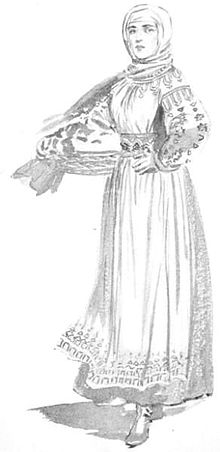 Hungarian peasant in the 17th century - illustration by Percy Anderson for Costume Fanciful, Historical and Theatrical, 1906 | |
| General Statistics | |
|---|---|
| Maternal mortality (per 100,000) | 21 |
| Women in parliament | 12.6% (2018)[1] |
| Women over 25 with secondary education | 93.2% (2010) |
| Women in labour force | 63% (employment rate OECD definition, 2019)[2] |
| Gender Inequality Index[3] | |
| Value | 0.221 (2021) |
| Rank | 55th out of 191 |
| Global Gender Gap Index[4] | |
| Value | 0.699 (2022) |
| Rank | 88th out of 146 |
| Part of a series on |
| Women in society |
|---|
 |
The roles of women in Hungary have changed significantly over the past 200 years. Historically, in the present day territory of Hungary, discourses on women’s roles, rights, and political access, along with feminist movements, have developed within the context of extremely traditional gender roles that were influenced by Roman Catholicism, Lutheranism and Calvinism. More recently, the Communist doctrine on women’s place in society was also influential. The post-communist era in Hungary has produced a number of organizations to address the needs of the nation’s women and mobilize female voters, and several universities now have gender studies programs. In the 21st century, the entry in the European Union has led to a more 'Westernized' culture.
- ^ "Women in Parliaments: World Classification".
- ^ OECD. "LFS by sex and age - indicators". stats.oecd.org. Retrieved 7 October 2017.
- ^ "Human Development Report 2021/2022" (PDF). HUMAN DEVELOPMENT REPORTS. Retrieved 17 November 2022.
- ^ "Global Gender Gap Report 2022" (PDF). World Economic Forum. Retrieved 24 February 2023.